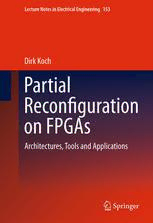Table Of ContentPartial Reconfiguration on FPGAs
Lecture Notes in Electrical Engineering
Volume 153
Forfurthervolumes:
http://www.springer.com/series/7818
Dirk Koch
Partial Reconfiguration
on FPGAs
Architectures, Tools and Applications
123
DirkKoch
UniversityofOslo
Oslo,Norway
ISBN978-1-4614-1224-3 ISBN978-1-4614-1225-0(eBook)
DOI10.1007/978-1-4614-1225-0
SpringerNewYorkHeidelbergDordrechtLondon
LibraryofCongressControlNumber:2012932628
©SpringerScience+BusinessMediaNewYork2013
Thisworkissubjecttocopyright.AllrightsarereservedbythePublisher,whetherthewholeorpartof
thematerialisconcerned,specificallytherightsoftranslation,reprinting,reuseofillustrations,recitation,
broadcasting,reproductiononmicrofilmsorinanyotherphysicalway,andtransmissionorinformation
storageandretrieval,electronicadaptation,computersoftware,orbysimilarordissimilarmethodology
nowknownorhereafterdeveloped.Exemptedfromthislegalreservationarebriefexcerptsinconnection
with reviews or scholarly analysis or material supplied specifically for the purpose of being entered
and executed on a computer system, for exclusive use by the purchaser of the work. Duplication of
this publication or parts thereof is permitted only under the provisions of the Copyright Law of the
Publisher’slocation,initscurrentversion,andpermissionforusemustalwaysbeobtainedfromSpringer.
PermissionsforusemaybeobtainedthroughRightsLinkattheCopyrightClearanceCenter.Violations
areliabletoprosecutionundertherespectiveCopyrightLaw.
Theuseofgeneraldescriptivenames,registerednames,trademarks,servicemarks,etc.inthispublication
doesnotimply,evenintheabsenceofaspecificstatement,thatsuchnamesareexemptfromtherelevant
protectivelawsandregulationsandthereforefreeforgeneraluse.
While the advice and information in this book are believed to be true and accurate at the date of
publication,neithertheauthorsnortheeditorsnorthepublishercanacceptanylegalresponsibilityfor
anyerrorsoromissionsthatmaybemade.Thepublishermakesnowarranty,expressorimplied,with
respecttothematerialcontainedherein.
Printedonacid-freepaper
SpringerispartofSpringerScience+BusinessMedia(www.springer.com)
Preface
Theresearchonpartialruntimereconfigurationhasa historythatis aslongasthe
greathistoryofFPGAs.However,despiteatimeframeofmorethantwodecades,
theworkonpartialreconfigurationhasnotfounditswayintocommercialsystems
yet, and is still considered very exotic. This is an interesting phenomenon as the
benefitsinsavingcostlyFPGAresourcesandpowerconsumptioncanbesubstantial.
One reason for this phenomenon is that implementing partially reconfigurable
systems is by far more difficultwith ASIC-like design tools when comparedwith
simplybuildingstaticonlysystemsthatomitthisnicefeature.
There is a long list of system constraints, FPGA specific issues, problems
with the design tools, documentationsecrets, and missing techniquesfor resource
managementat runtime, that have to be processed to get a reconfigurable system
running. Moreover, all these obstacles have to be understood in order to be
able to build reconfigurable systems which gain a significant improvement over
conventional static implementations, and which are reliable. In other words, it is
typicallynotsufficienttohaveasimplifiedproofofconceptimplementationinorder
tobuildreconfigurablesystemsonalargescale.
Throughout this book, all major obstacles will be explained together with
solutions. The goal of this book is to tackle the problems that come along with
partialruntimereconfiguration,inasystematicway.Thisisdonebyproposingtools
thatare aware of the issues related to partialruntimereconfiguration,hidingmost
low level implementation details from a design engineer. By doing this, an error
pronedesignflowisomittedandreproducibleresultscanbeguaranteed.
ThisbookdoesnotprovideageneralintroductionintoFPGAdesigntechniques,
which is already nicely covered in numerous textbooks. Here, the focus is put,
in particular, on the effects of partial runtime reconfiguration that are not deeply
coveredbyothertextbooksasyet.However,readersofthisbookarenotexpectedto
havedeepknowledgeabouthardwaredesignandFPGA technology;allnecessary
technicalbasicshavebeenprovided.
This book has been written for design engineers who are interested in investi-
gatingruntimereconfiguration.Moreover,the bookalso targetsgraduatestudents,
lecturers and researchers working in the field. The book provides theoretical and
v
vi Preface
practical background, as well as design experience gathered through a decade of
workingwithreconfigurabledevicesandsystems.
Finally, this is the first issue of this book, and despite the review effort, there
are probably some remaining mistakes. Therefore, I will be grateful to receive
yourcommentsinthisregard.Moreover,thisbookreflectsmanyyearsofpersonal
experience,andtheknowledgesharedbymanygreatcolleaguesandstudentswhom
ImetsincestartingmyworkonFPGAs.However,manyreadershavegatheredtheir
ownexperiencewhenusingpartialreconfiguration,andIamverypleasedwhenever
theysharetheirexperienceswithme.
Oslo,Norway DirkKoch
Contents
1 Introduction .................................................................. 1
1.1 BasicDefinitionsonReconfigurableComputing..................... 3
1.2 ReconfigurableFPGATechnology.................................... 6
1.2.1 ReconfigurableLogiconFPGAs ............................. 6
1.2.2 ReconfigurableRoutingonFPGAs........................... 9
1.2.3 PuttingThingsTogether:ASimpleFPGAArchitecture .... 11
1.3 BenefitsofPartialReconfiguration.................................... 15
1.3.1 AreaandPowerReduction.................................... 17
1.3.2 PerformanceImprovement.................................... 18
1.3.3 FastSystemStart .............................................. 21
1.4 BasicModelofPartialReconfiguration............................... 22
1.5 PartialReconfigurationinTime ....................................... 24
1.5.1 Sub-CycleReconfiguration ................................... 24
1.5.2 Single-CycleReconfiguration................................. 27
1.5.3 Multi-CycleReconfiguration.................................. 29
1.6 PartialReconfigurationinSpaceandTime ........................... 29
1.6.1 SmallNetlistManipulations .................................. 30
1.6.2 IslandStyleReconfiguration.................................. 31
1.6.3 FPGAFootprintandModuleFootprint....................... 33
1.6.4 One-dimensionalSlot-styleReconfiguration................. 36
1.6.5 Two-dimensionalGrid-styleReconfiguration................ 37
1.7 PartialReconfigurationasFPGAContextSwitching................. 38
1.8 Overview................................................................ 40
2 Intra-FPGA Communication Architectures
forReconfigurableSystems................................................. 43
2.1 PreconsiderationsonFlexibilityandModulePlacement............. 44
2.2 EfficiencyPreconsiderations........................................... 45
2.3 FPGAArchitectureModel............................................. 48
2.4 RelatedWorkonCommunicationforReconfigurableSystems...... 53
2.4.1 CircuitSwitching.............................................. 54
vii
viii Contents
2.4.2 NetworksonaChip ........................................... 58
2.4.3 Buses........................................................... 60
2.4.4 PhysicalImplementationTechniques......................... 65
2.4.5 ProxyLogic.................................................... 71
2.4.6 ZeroLogicOverheadIntegration............................. 72
2.5 Bus-BasedCommunicationforReconfigurableSystems............. 75
2.5.1 SharedWriteSignals.......................................... 77
2.5.2 DedicatedWriteSignals....................................... 80
2.5.3 SharedReadSignals........................................... 88
2.5.4 DedicatedReadSignals....................................... 94
2.5.5 Module-to-ModuleReCoBusCommunication .............. 100
2.5.6 BusesforTwo-dimensionalPlacement....................... 102
2.6 Point-to-PointCommunication ........................................ 104
2.6.1 One-dimensionalOnlineCircuitSwitching.................. 107
2.6.2 Two-dimensionalOnlineCircuitSwitching.................. 110
2.7 ExperimentalResults................................................... 114
2.7.1 ReCoBusTimingCharacteristics............................. 115
2.7.2 LogicCostoftheReCoBusArchitecture .................... 124
2.7.3 TheImpactofModularizationonthePhysical
Implementation................................................ 129
2.7.4 Glitch-freeReconfiguration................................... 131
2.7.5 CommunicationforTwo-dimensionalModulePlacement .. 137
2.8 ChapterContributionsandDiscussion ................................ 146
3 BuildingPartiallyReconfigurableSystems:MethodsandTools ....... 149
3.1 AFrameworkforComponent-BasedReconfigurable
SystemDesign.......................................................... 150
3.2 ReCoBus-Builder:ABuilderforReconfigurableSystems........... 153
3.2.1 Floorplanning.................................................. 155
3.2.2 ReCoBusGeneration.......................................... 156
3.2.3 ConnectionBarGeneration................................... 158
3.2.4 RoutingConstraints(Blocking)............................... 159
3.2.5 TimingSpecification .......................................... 162
3.2.6 BitstreamAssemblyandHardwareLinking ................. 162
3.2.7 SimulatingRuntimeReconfiguration......................... 164
3.3 Core-BasedSystemDesign............................................ 167
3.4 RuntimeReconfiguration .............................................. 168
3.4.1 HorizontalBitstreamRelocation.............................. 169
3.4.2 VerticalBitstreamRelocation................................. 170
3.4.3 SmallBitstreamManipulations............................... 173
3.5 HighSpeedReconfiguration........................................... 174
3.5.1 ConfigurationPrefetching..................................... 174
3.5.2 ConfigurationPortOverclocking............................. 175
3.5.3 HardwareAcceleratedBitstreamDecompression ........... 176
3.5.4 AlgorithmsforBitstreamCompression ...................... 179
Contents ix
3.5.5 BenchmarkingBitstreamDecompressionAccelerators..... 189
3.5.6 High-speedDefragmentation ................................. 192
3.6 ChapterSummaryandContributions.................................. 198
4 Self-adaptiveReconfigurableNetworks................................... 199
4.1 HardwareCheckpointing............................................... 201
4.1.1 RelatedWorkonHardwareCheckpointing .................. 202
4.1.2 FSM-basedTaskModel....................................... 203
4.1.3 CheckpointingInputandOutputStates ...................... 205
4.2 AccessingModuleStates............................................... 207
4.2.1 Memory-MappedStateAccess ............................... 208
4.2.2 StateAccessviaScanChains................................. 209
4.2.3 StateAccessviaShadowScanChains ....................... 211
4.2.4 AutomaticHardwareTransformationwithStateAccess..... 211
4.2.5 FurtherModuleTransformationsandLimitations........... 213
4.2.6 ExperimentalEvaluation...................................... 213
4.2.7 CheckpointingviaFPGAReadbackTechniques............. 216
4.2.8 HardwareCheckpointingin Heterogeneous
FPGAEnvironments .......................................... 219
4.3 Hardware/SoftwareMorphing......................................... 220
4.3.1 RelatedWorkonHardware/SoftwareMorphing............. 220
4.3.2 ModelingHardware/SoftwareMorphing..................... 222
4.3.3 StateTranslation............................................... 224
4.3.4 DesignFlowforImplementingMorphableTasks ........... 227
4.3.5 MorphingCaseStudy ......................................... 229
4.4 ChapterSummary ...................................................... 230
5 ReconfigurableCPUInstructionSetExtensions ......................... 235
5.1 On-FPGACommunicationforCustomInstructions.................. 236
5.2 ZeroLogicOverheadIntegration...................................... 238
5.2.1 StaticSystemConstraints..................................... 239
5.2.2 PartialModuleConstraints.................................... 239
5.2.3 CommunicationBindingbyWireAllocation................ 240
5.3 Implementing Reconfigurable Instructions
withtheReCoBus-Builder............................................. 241
5.4 CaseStudyonCustomInstructions ................................... 242
5.4.1 StaticSystemImplementation................................ 243
5.4.2 ReconfigurableInstructions................................... 245
5.4.3 ResultsandOverheadAnalysis............................... 245
6 ConcludingRemarks........................................................ 249
6.1 FutureDirections....................................................... 251
A Appendix ..................................................................... 253
A.1 TheToolGOAHEAD ................................................... 253
A.2 AReconfigurableHello WorldSystem........................... 255

